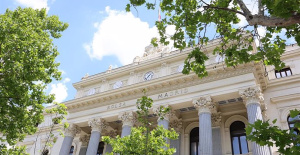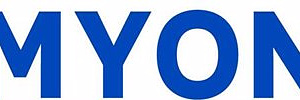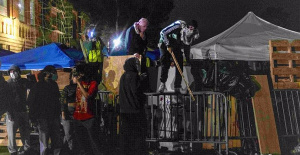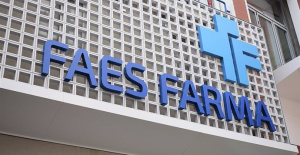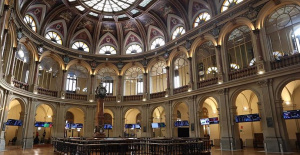ALICANTE, 24 Nov. (EUROPA PRESS) -
The Higher Polytechnic School (EPS) of the University of Alicante (UA) has recently acquired an exoskeleton, a technology with "great potential" in the current robotics industry, with the aim of improving the training of future robotics and biomedical engineers and providing them with " "appropriate and state-of-the-art teaching instruments for the study of rehabilitation robotics".
Robotic exoskeletons have "great utility" in the clinical field as elements of assistance and movement rehabilitation, as well as in the professional field to help lift heavy weights or for arduous work that requires uncomfortable positions sustained over time, according to indicated the academic institution in a statement.
The professor of the Department of Physics, Systems Engineering and Signal Theory, Andrés Úbeda, has pointed out that the exoskeleton industry has experienced "a great boom" in recent years and has highlighted that it is "a key element in training of future robotics and biomedical engineers.
Specifically, more than 150 students from the UA's Robotics Engineering and Biomedical Engineering degrees and master's degrees in Biomedical Engineering and Automation and Robotics will work with the exoskeleton during this academic year to contribute to their scientific and educational future.
In this sense, the UA Higher Polytechnic School, together with the Department of Physics, Systems Engineering and Signal Theory, has taken a "significant step" in innovation and teaching in biotechnology and robotics with the acquisition of the BELK exoskeleton.
"Students trained in this subject will have the ability to join companies in the sector and also undertake their own projects since, being a growing field, the possibilities of developing new devices that adjust to the new needs of the market are high. ", stressed the UA professor.
In addition, he added that they will be able to contribute their knowledge in the field of research related to the use and application of exoskeletons, with the aim of improving current rehabilitation processes and limiting the negative effects of diseases of the neuromuscular system.
The application of exoskeletons in the clinical setting is mainly indicated for patients who have suffered a stroke or spinal cord injury. According to data from the World Stroke Organization medical association, it is estimated that annually about 12.2 million people suffer a stroke and the total number of survivors is approximately 101 million worldwide. In the case of people with spinal cord injury, the figures rise to 250,000 and 500,000 people annually, according to data from the World Health Organization.
"These are the two pathologies with the highest prevalence, although any illness or injury that requires assistance can allow the use of exoskeletons if the conditions are met," Úbeda stressed.

 Exploring Cardano: Inner Workings and Advantages of this Cryptocurrency
Exploring Cardano: Inner Workings and Advantages of this Cryptocurrency Seville.- Economy.- Innova.- STSA inaugurates its new painting and sealing hangar in San Pablo, for 18 million
Seville.- Economy.- Innova.- STSA inaugurates its new painting and sealing hangar in San Pablo, for 18 million Innova.- More than 300 volunteers join the Andalucía Compromiso Digital network in one month to facilitate access to ICT
Innova.- More than 300 volunteers join the Andalucía Compromiso Digital network in one month to facilitate access to ICT Innova.-AMP.- Ayesa acquires 51% of Sadiel, which will create new technological engineering products and expand markets
Innova.-AMP.- Ayesa acquires 51% of Sadiel, which will create new technological engineering products and expand markets A ball of light crosses Spain and Portugal
A ball of light crosses Spain and Portugal Prime Minister Fico is stabilized within gravity
Prime Minister Fico is stabilized within gravity Israel's Minister for the Diaspora considers Sánchez "responsible" for there being "more victims" in Gaza
Israel's Minister for the Diaspora considers Sánchez "responsible" for there being "more victims" in Gaza Barça strikes down Real to lift the Queen's Cup
Barça strikes down Real to lift the Queen's Cup How Blockchain in being used to shape the future
How Blockchain in being used to shape the future Not just BTC and ETH: Here Are Some More Interesting Coins Worth Focusing on
Not just BTC and ETH: Here Are Some More Interesting Coins Worth Focusing on The UA participates in the proposed Ramses mission to study the close passage of an asteroid to Earth
The UA participates in the proposed Ramses mission to study the close passage of an asteroid to Earth They develop a tool to end discrimination biases in AI
They develop a tool to end discrimination biases in AI A research group from the UA works on the development of healthy foods through AI
A research group from the UA works on the development of healthy foods through AI The Valencian researcher José Rafael Penadés, named 'fellow' of the British Royal Society
The Valencian researcher José Rafael Penadés, named 'fellow' of the British Royal Society A million people demonstrate in France against Macron's pension reform
A million people demonstrate in France against Macron's pension reform Russia launches several missiles against "critical infrastructure" in the city of Zaporizhia
Russia launches several missiles against "critical infrastructure" in the city of Zaporizhia A "procession" remembers the dead of the Calabria shipwreck as bodies continue to wash up on the shore
A "procession" remembers the dead of the Calabria shipwreck as bodies continue to wash up on the shore Prison sentences handed down for three prominent Hong Kong pro-democracy activists
Prison sentences handed down for three prominent Hong Kong pro-democracy activists ETH continues to leave trading platforms, Ethereum balance on exchanges lowest in 3 years
ETH continues to leave trading platforms, Ethereum balance on exchanges lowest in 3 years Investors invest $450 million in Consensys, Ethereum incubator now valued at $7 billion
Investors invest $450 million in Consensys, Ethereum incubator now valued at $7 billion Alchemy Integrates Ethereum L2 Product Starknet to Enhance Web3 Scalability at a Price 100x Lower Than L1 Fees
Alchemy Integrates Ethereum L2 Product Starknet to Enhance Web3 Scalability at a Price 100x Lower Than L1 Fees Mining Report: Bitcoin's Electricity Consumption Declines by 25% in Q1 2022
Mining Report: Bitcoin's Electricity Consumption Declines by 25% in Q1 2022 Oil-to-Bitcoin Mining Firm Crusoe Energy Systems Raised $505 Million
Oil-to-Bitcoin Mining Firm Crusoe Energy Systems Raised $505 Million Microbt reveals the latest Bitcoin mining rigs -- Machines produce up to 126 TH/s with custom 5nm chip design
Microbt reveals the latest Bitcoin mining rigs -- Machines produce up to 126 TH/s with custom 5nm chip design Bitcoin's Mining Difficulty Hits a Lifetime High, With More Than 90% of BTC Supply Issued
Bitcoin's Mining Difficulty Hits a Lifetime High, With More Than 90% of BTC Supply Issued The Biggest Movers are Near, EOS, and RUNE during Friday's Selloff
The Biggest Movers are Near, EOS, and RUNE during Friday's Selloff Global Markets Spooked by a Hawkish Fed and Covid, Stocks and Crypto Gain After Musk Buys Twitter
Global Markets Spooked by a Hawkish Fed and Covid, Stocks and Crypto Gain After Musk Buys Twitter Bitso to offset carbon emissions from the Trading Platform's ERC20, ETH, and BTC Transactions
Bitso to offset carbon emissions from the Trading Platform's ERC20, ETH, and BTC Transactions Draftkings Announces 2022 College Hoops NFT Selection for March Madness
Draftkings Announces 2022 College Hoops NFT Selection for March Madness











